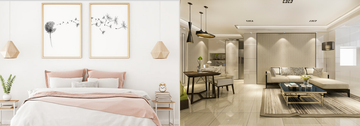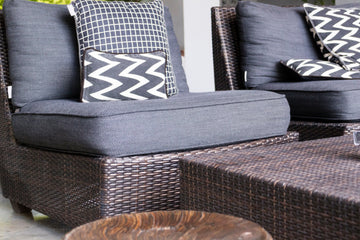In a world overflowing with options, trends, and an endless barrage of products, we always feel like we want more; like we are missing something. This urge leads to impulsive splurging leading to a home filled with unnecessary clutter, mismatched items, and an overwhelming array of possessions; our living spaces can quickly lose their intended purpose.
Minimalism offers an antidote to this modern malaise. It's not just about having less than what you need; it is about making room for more peace, clarity, and elegance. The minimalist design philosophy offers a refreshing alternative: simplicity; stripping away the non-essential items in your house or room and retaining what truly really matters.
Achieving minimalism in your home is not always about throwing things away—it's about thoughtful curation and creating an environment that looks and feels elegant through simplicity. While this may sound difficult, it is fun and feels invigorating as the results start showing. If you are looking at going minimal to bring in certain tranquility in your life, let's delve into the art of achieving a clutter-free, elegant home.
Understanding Minimalism: Beyond Just a Trend
If you are latching on to minimalism now, it's wonderful and never too late. It is a lifestyle choice about living with an intention and about making deliberate choices. It is a philosophy that encourages you to focus on quality, discouraging quantity, even if cheap, thus choosing items that serve a purpose and bring you joy.
What is the key principle of minimalist home design?
While you may have heard or read about many principles of minimalism, the key principle of minimalist home design is intentionality. Intent is where it begins. A minimalist space serves a purpose, whether functional or aesthetic. This principle ensures that your space remains clutter-free, as every piece has a reason for being there.
How to Begin: Decluttering Your Space
The first step to achieving minimalism is decluttering. This doesn't mean you have to throw everything away, but rather assess each item's value in your life. Start with one room and gradually move through every room and storage. If in doubt, ask yourself if the item serves a purpose? Does it bring you joy? If the answer is no, maybe it's time to let it go.
Tips for Decluttering:
-
The One-Year Rule: If you haven't used it in the past year, you don't need it.
-
Sentimental Items: Keep only those with significant meaning and find ways to display or store them creatively.
-
Quality Over Quantity: Replace multiple lower-quality items with a single high-quality piece that serves the same purpose.
As you declutter, consider storage solutions that are both practical and stylish. Storage baskets that are perfect for keeping your essentials organized without compromising on the elegance of your spaces.
Choosing a Neutral Color Palette
One of the hallmarks of minimalist design is a neutral color palette. Whites, grays, and beiges create a calming and clean atmosphere. This doesn't mean your home has to be devoid of color—minimalism often uses accent colors sparingly to create focal points.
Why are neutral colors important in minimalism?
Neutral colors are important in minimalism because they create a sense of calm and order. They allow the space to feel open and uncluttered, which is essential in minimalist design. Additionally, neutral tones provide a perfect backdrop for accent pieces, making those items stand out.
To enhance your minimalist design, consider adding Fabrica Kraft's custom leather cushions in various colors and finishes to complement your interiors.
Investing in Multi-Functional Furniture
Minimalism emphasizes functionality. In a minimalist home, each piece of furniture should serve a purpose, often more than one. Multi-functional furniture is vital to maintaining a clutter-free environment while ensuring your space remains comfortable and livable.
Examples of Multi-Functional Furniture:
- Sofa Beds: Perfect for small spaces, serving as both seating and sleeping areas.
- Storage Ottomans: Provides additional seating while offering hidden storage.
-
Extendable Dining Tables: Adaptable for both everyday meals and entertaining guests.
At Fabrica Kraft, our Tailored Sunbrella Cushions are designed with minimalism in mind, blending form and function effortlessly.
Incorporating Simple, High-Quality Decor
In minimalism, decor should be carefully chosen and not overdone. A few well-placed, high-quality artifacts can have a more significant impact than a room full of trinkets. Choose decor that complements the neutral color palette and enhances the overall aesthetic of your space.
What kind of decor works best in a minimalist home?
Minimalist decor often includes items made from natural materials such as wood, stone, or leather. These materials add texture and warmth without overwhelming the space. Simple artwork, strategically placed mirrors, and personal items can add character to a minimalist home.
For that added touch of luxury, you can incorporate custom-designed velvet cushion covers or decor pieces from Fabrica Kraft. These items blend seamlessly into a minimalist design while adding a luxurious touch.
In case you are redecorating your study room or a corner where you can relax after a tiring day like your cocoon to rejuvenate you might want to check our blog post about creating the perfect corner to relax and unwind.
Lighting: The Unsung Hero of Minimalism
Lighting plays a crucial role in the success of any interior design plan, whether it is a bedroom, study, or drawing room. Planned and efficient lighting can make a space feel larger, more open, and inviting. Natural light is ideal, so use windows and avoid heavy curtains blocking the light. For artificial lighting, choose fixtures that are simple yet stylish.
What about lighting? How do I manage lighting when adopting the minimalist philosophy?
The charm of a minimalist home is the open and airy feel of the space. Good lighting highlights the simplicity of the design and ensures that the space feels warm and welcoming.
Adding Personal Touches
While minimalism emphasizes simplicity, adding personal touches that make your home feel uniquely yours will add to the sweet home factor. Use a family heirloom, a piece of art that you love, or a collection of books that inspire you. These personal items add warmth and character to a minimalist home without cluttering the space.
How to Incorporate Personal Items while practising minimalism?
Incorporating personal items into a minimalist home requires careful curation. Choose items that hold significant meaning and find ways to display them without your home feeling cluttered or chaotic. This is where personal touches can make a minimalist home feel warm and inviting. Choose items that hold deep meaning or sentimental value, and find ways to integrate them into your space without overwhelming the minimalist aesthetic.
Maintaining a Minimalist Lifestyle
Achieving minimalism isn't just about the initial setup; it's about maintaining the lifestyle. Regularly reassess your possessions and ensure everything in your home still serves a purpose. Minimalism is a journey, not a destination. It requires ongoing commitment and mindfulness.
How can you maintain a minimalist home?
Maintaining a minimalist home requires regular decluttering, thoughtful purchasing decisions, and a commitment to simplicity. Set aside time each season to reassess your space and adjust as needed. Like all the good things in life, focusing on quality over quantity can ensure your home remains a sanctuary of simplicity and elegance, gathering accolades for its minimalist charm.
Sustainable Minimalism: Making Eco-Friendly Choices
Minimalism and sustainability go hand in hand. The minimalist approach naturally aligns with eco-friendly practices by promoting the idea of buying less and choosing high-quality, long-lasting items. By making mindful choices, you create a beautiful, clutter-free home and contribute to a healthier planet.
Sustainable Practices in Minimalist Design
-
Choose Eco-Friendly Materials: Sustainable is the buzzword, and decor items made from sustainable materials like treated reclaimed wood, recycled metals, or natural fibers are trending.
-
Prioritize Durability: Invest in high-quality items that are built to last longer, though they might be comparatively expensive. This reduces the need for replacements & repairs.
-
Mindful Consumption: Be intentional about your purchases, focusing on items that serve a purpose and align with your values. Remember, intention is the key to maintaining a minimalist lifestyle.
Why is sustainability important in minimalist design?
Sustainability is an important aspect of a minimalist lifestyle. It reinforces the principles of intentionality and mindfulness, choosing eco-friendly materials and durable products, reducing waste, and creating a home that is as beautiful as it is environmentally responsible.
Fabrica Kraft's sustainable home decor products are crafted with environmental safety in mind, offering eco-friendly options that align with minimalist design principles.
Minimalism is a journey you will love. It's about continually refining your space and making thoughtful choices that enhance your life and home. By adopting a minimalist approach, you create room for more peace, joy, and beauty in your everyday life.






